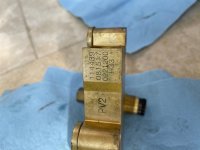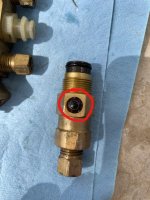Do you know if there is supposed to be any type of sealant on the threads, or are they made to just be brass on brass?
Because it's under pressure I don't think the thread sealer would be a fix, or even a Band-Aid to a leaking o-ring. Not sure though, so maybe someone else knows. However I'm pretty sure they don't use sealant.
In fact, most recommendations say don't use thread sealer on brake system threads. Don't want anything getting too far in and blocking a port or tube.
Separately, any idea if there are other / better valves that aren't prone to leaking? I saw Wild Horses sells a MOAB valve, but not sure if that works with my application.
Yes, there are other brands that look just like yours, and other types. Our MOAB systems use manually adjustable proportioning valves (from Wilwood), so are a different type altogether. But they're simple, work well and almost never seem to leak. And when they do, it's usually a tube fitting and then those are easy to fix like you would any fluid leak out of a tube.
There are advantages to both types, but it sure would be nice to find a brand of combination valve that was at least more leak-free than most of these others that look like yours. They do work, and they do their jobs, and they sometimes even don't leak. But the percentage of leakers was far too high for me. We still sell them, and back them with replacements (or replacement parts) if yours leak, but we can't test them in-house to see if they leak before shipping them out. And even if we could, the leaks don't always happen immediately, but a few weeks or months down the road. So it could look perfectly good when tested, then leak later. Always something. Right?
I have a manually adjustable one on my '68 and have had no trouble with it. I have a regular stock one on my '79 pickup that I will continue to use (hopefully) once I pull it apart and rebuild it. The metering valve is apparently stuck because I have no front brakes. I can lock up the rears with a gentle push on the pedal, but the fronts do nothing.
So yes, that means that the combination valves for all their goodness definitely offer more failure points than a simple adjustable one. Never heard of one of them failing, though I'm sure it's possible.
As for raising yours or any other up like you want to, that's a great idea and many members here have done it with both the aftermarket and the original combination valves. The two most common positions are either bolted directly to the wheel well just under the master cylinder, or to a bracket connected to the master cylinder directly. That's how our MOAB setup works by the way. The kit comes with new hard lines that are strong enough to hold the valve all by themselves, but that come with a bracket for that extra support anyway. Can't be too careful when it comes to designing a brake system.
If you're going to do it yourself, it's also up to you to make your own hard lines, or have them made to your specifications by someone that does that sort of thing. Companies like "Inline Tube" and others do it all the time. They can often do tight bends like are extremely hard to impossible to do by hand at home.
But for basic shaping/forming of hard lines, it's a fairly simple procedure. You can buy inexpensive bending tools, or even create your own if you're the clever type. You can buy pre-flared lengths of the correct size tubing at most auto parts stores. They come in various lengths from probably as short as 4 or 6 inches, to 36 inches and probably longer.
You figure out how much length you will need to incorporate the bends and end up where you want to at each end, then start the bending process.
It's actually quite fun and relaxing. Well, except for the tool throwing episodes when you kink a tube or find out you used one that ended up not long enough! And yet those are somehow relaxing episodes too sometimes.
Gotta get it out of your system after all. And more tubing is not that much of an expense when you compare it to what else you've spent on the Bronco!
Lots of threads around here showcasing what members have done with their tubing.
Paul














